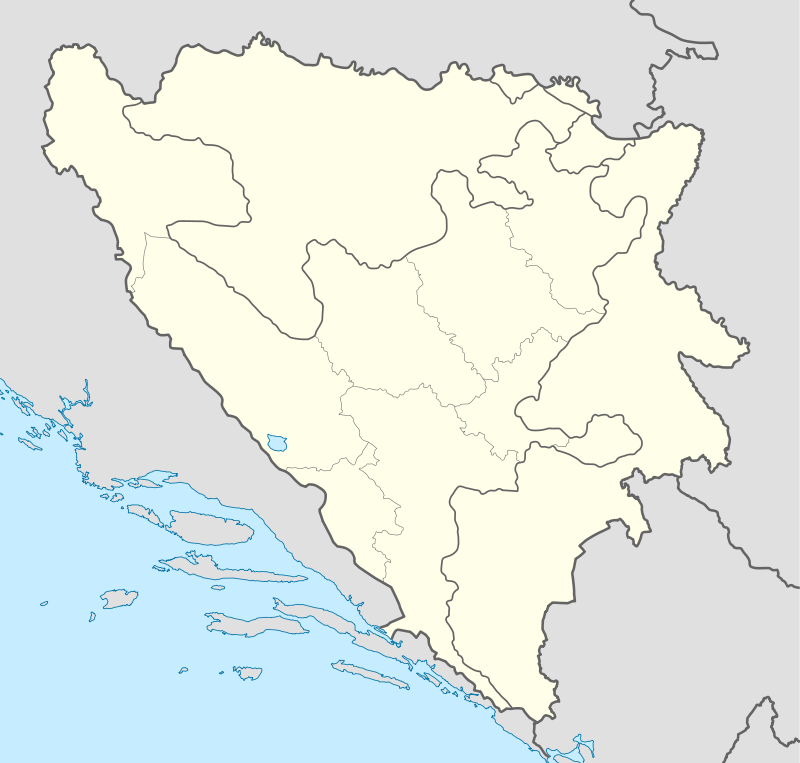Rašćani
| Rašćani | |
|---|---|
| Village | |
 Rašćani | |
| Coordinates: BA 43°41′27″N 17°17′51″E / 43.69083°N 17.29750°E | |
| Country |
|
| Entity | Federation of Bosnia and Herzegovina |
| Canton |
|
| Municipality | Tomislavgrad |
| Area | |
| • Total | 334 sq mi (8,66 km2) |
| Time zone | CET (UTC+1) |
| • Summer (DST) | CEST (UTC+2) |
Rašćani (Serbian Cyrillic: Рашћани) is a village in the municipality of Tomislavgrad, Bosnia and Herzegovina.[1]
Name
It is likely that the village received the name from its first settlers, Serbs, also called Rašani.[2]
Geography
The village is located near Tomislavgrad (previously known as Duvno).[3]
History
The village was inhabited exclusively by ethnic Serbs.[4] The Orthodox village church was founded in 1891.[3] In the early 1930s, many of the young craftmen left the village for Austria.[5] During World War II, the Ustashe carried out atrocities in the village.[6]
With the outbreak of the Bosnian War, the village was blockaded, and subsequently Serbs were looted and murdered.[7] The Serbs included refugees from Croatia.[8] The village was transformed into a prisoner camp by Croat forces.[6][9] The only Serb village in Duvno, from the beginning of April 1992 to 29 June 1993, more than 300 Serbs were victims of daily torture and threats, including 40 children younger than 12 years.[6] In 1992, around 1,000 Serbs held hostage in the village were unable to receive food and other necessarites.[10] In January 1993, this number was at c. 840.[11] The Croat authorities did not permit humanitarian aid to reach the Serbs.[9] The village church was burnt[12] and destroyed in 1992, being the first religious building destroyed in Bosnia and Herzegovina in the war.[6] The municipality of Tomislavgrad is the only municipality in which not a single Serb refugee has returned.[6]
Culture
- Serbian Orthodox Church dedicated to The Entry of the Most Holy Theotokos, built in 1891.[3]
Demographics
According to the 2013 Census preliminary results, the village was inhabited by 41 people.[13] The 1991 census recorded 102 Serbs and 1 Yugoslav.[13]
Anthropology
Families:
- Važić, with the slava of Jovanjdan (St. John). They hail from Gorski kotar, from where they fled Ottoman tyranny, while another story have them settling from Montenegro.[14]
- Karan. They hail from Lika.[14]
Many families left during the Bosnian War for Aranđelovac, in Serbia.[6]
See also
- Baljci, the only other Serb-majority village in Tomislavgrad
References
- ↑ Official results from the book: Ethnic composition of Bosnia-Herzegovina population, by municipalities and settlements, 1991. census, Zavod za statistiku Bosne i Hercegovine - Bilten no.234, Sarajevo 1991.
- ↑ Srpsko geografsko društvo (1948). Glasnik Srpskog geografskog društva. 1; 5-6. Srpsko geografsko društvo. p. 157.
- 1 2 3 Dimitrije M. Kalezić (2002). P - Š. Savremena administracija. p. 1614.
- ↑ Monografije. 38-39. Fakultet. 1971. p. 48.
- ↑ Milivoje M. Savić (1933). Naša industrija, zanati i trgovina: njine osnovice, stanje, odnosi, važnost, putevi, prošlost i budućnost. Izd. Ministarstva trgovine i industrije. p. 526.
- 1 2 3 4 5 6 Štrkić 2012.
- ↑ Ljiljana Bulatović (2001). General Mladić. Evro. p. 81.
- ↑ Helsinki Watch 1993.
- 1 2 FBIS Daily Report: East Europe. 25-32. The Service. 1993. p. 46.
- ↑ Vojska. 1. Vojnoizdavački i novinski centar. 1992. p. 80.
- ↑ http://www.nytimes.com/1993/01/22/world/croats-holding-240-serbs-in-a-bosnia-village.html. Missing or empty
|title=(help) - ↑ Milan Bulajić; Radovan Samardžić (1994). Sistem neistina o zločinima genocida 1991-1993. godine: Naučni skup Odbora SANU za sakupljanje građe o genocidu protiv srpskog naroda i drugih naroda Jugoslavije u XX veku, Državne komisije za ratne zločine i zločine genocida i Instituta za savremenu istoriju, održan od 22. do 23. aprila 1993. godine. Srpska akademija nauka i umetnosti. p. 45.
- 1 2 "Rašćani". NASBiH.
- 1 2 Jevto Dedijer (1991). Hercegovina: antropogeografske studije. Veselin Masleša. pp. 310–.
Sources
- Štrkić, N. (30 December 2012). "Rašćani - selo kojeg nema". Novosti.
- Helsinki Watch (1993). War Crimes in Bosnia-Hercegovina. Human Rights Watch. pp. 346–349. ISBN 978-1-56432-097-1.
External links
- "Galerija - Rašćani". Udruženje građana Srbi Duvna.
Coordinates: 43°41′27″N 17°17′51″E / 43.69083°N 17.29750°E